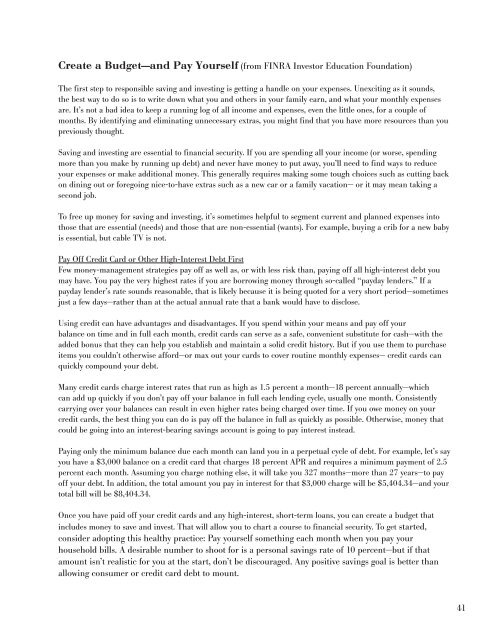Tips and Tools For Financial Success - Newton Free Library
Tips and Tools For Financial Success - Newton Free Library
Tips and Tools For Financial Success - Newton Free Library
Create successful ePaper yourself
Turn your PDF publications into a flip-book with our unique Google optimized e-Paper software.
Create a Budget—<strong>and</strong> Pay Yourself (from FINRA Investor Education Foundation)<br />
The first step to responsible saving <strong>and</strong> investing is getting a h<strong>and</strong>le on your expenses. Unexciting as it sounds,<br />
the best way to do so is to write down what you <strong>and</strong> others in your family earn, <strong>and</strong> what your monthly expenses<br />
are. It’s not a bad idea to keep a running log of all income <strong>and</strong> expenses, even the little ones, for a couple of<br />
months. By identifying <strong>and</strong> eliminating unnecessary extras, you might find that you have more resources than you<br />
previously thought.<br />
Saving <strong>and</strong> investing are essential to financial security. If you are spending all your income (or worse, spending<br />
more than you make by running up debt) <strong>and</strong> never have money to put away, you’ll need to find ways to reduce<br />
your expenses or make additional money. This generally requires making some tough choices such as cutting back<br />
on dining out or foregoing nice-to-have extras such as a new car or a family vacation— or it may mean taking a<br />
second job.<br />
To free up money for saving <strong>and</strong> investing, it’s sometimes helpful to segment current <strong>and</strong> planned expenses into<br />
those that are essential (needs) <strong>and</strong> those that are non-essential (wants). <strong>For</strong> example, buying a crib for a new baby<br />
is essential, but cable TV is not.<br />
Pay Off Credit Card or Other High-Interest Debt First<br />
Few money-management strategies pay off as well as, or with less risk than, paying off all high-interest debt you<br />
may have. You pay the very highest rates if you are borrowing money through so-called “payday lenders.” If a<br />
payday lender’s rate sounds reasonable, that is likely because it is being quoted for a very short period—sometimes<br />
just a few days—rather than at the actual annual rate that a bank would have to disclose.<br />
Using credit can have advantages <strong>and</strong> disadvantages. If you spend within your means <strong>and</strong> pay off your<br />
balance on time <strong>and</strong> in full each month, credit cards can serve as a safe, convenient substitute for cash—with the<br />
added bonus that they can help you establish <strong>and</strong> maintain a solid credit history. But if you use them to purchase<br />
items you couldn’t otherwise afford—or max out your cards to cover routine monthly expenses— credit cards can<br />
quickly compound your debt.<br />
Many credit cards charge interest rates that run as high as 1.5 percent a month—18 percent annually—which<br />
can add up quickly if you don’t pay off your balance in full each lending cycle, usually one month. Consistently<br />
carrying over your balances can result in even higher rates being charged over time. If you owe money on your<br />
credit cards, the best thing you can do is pay off the balance in full as quickly as possible. Otherwise, money that<br />
could be going into an interest-bearing savings account is going to pay interest instead.<br />
Paying only the minimum balance due each month can l<strong>and</strong> you in a perpetual cycle of debt. <strong>For</strong> example, let’s say<br />
you have a $3,000 balance on a credit card that charges 18 percent APR <strong>and</strong> requires a minimum payment of 2.5<br />
percent each month. Assuming you charge nothing else, it will take you 327 months—more than 27 years—to pay<br />
off your debt. In addition, the total amount you pay in interest for that $3,000 charge will be $5,404.34—<strong>and</strong> your<br />
total bill will be $8,404.34.<br />
Once you have paid off your credit cards <strong>and</strong> any high-interest, short-term loans, you can create a budget that<br />
includes money to save <strong>and</strong> invest. That will allow you to chart a course to financial security. To get started,<br />
consider adopting this healthy practice: Pay yourself something each month when you pay your<br />
household bills. A desirable number to shoot for is a personal savings rate of 10 percent—but if that<br />
amount isn’t realistic for you at the start, don’t be discouraged. Any positive savings goal is better than<br />
allowing consumer or credit card debt to mount.<br />
41




